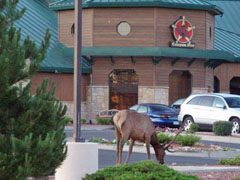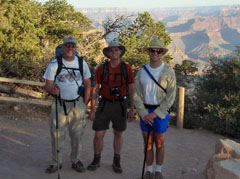|
It's summer, and I have managed to keep free of work. Teaching is
a great profession that way, especially if you like to hike the Grand
Canyon. Well, optimal hiking is in the fall and spring, so there
is a bit of a mismatch here. Still, once the monsoon season starts
to kick in, here in northern Arizona, day hiking the canyon can be quite
enjoyable. As the heat builds up during the day, the clouds roll
in, mitigating temperatures, and, if all goes well, they will dump a bit
of rain on you, to really cool things off. May and June are not
like that - those are our driest months. But, July and August can
be great hiking times, if the weather is cooperating.
It looked like this would be a good day for a hike, despite it being Friday the thirteenth! The forecast was for highs in the low 80s at the rim, and about 110 degrees at the river. But, we also had afternoon clouds in the forecast, with a 20%-30% chance of a thunderstorm. Hiking buddies John Eastwood and Bill Ferris were up to the challenge of a midsummer's day nightmare down into the canyon. To make it even more challenging, we were going to take the South Kaibab in, and out, of the canyon. There is a perception of dread about this trail, at least for the hike out, because there is no water along the route, and there is not nearly as much shade as along the Bright Angel trail. But, perception is not necessarily reality. The key advantage to the Kaibab trail is that it is about two miles shorter than the Bright Angel. Also, on the return hike, you start climbing right away along the Kaibab, mitigating the heat at the time you are hiking at your strongest. Along the Bright Angel, you have to hike above the river to Pipe Creek, broiling all the way. And, the shade issue is overplayed. There are many great shady spots along the Kaibab, from near the river to the switchbacks at the very top. Bill volunteered to provide the wheels for this hike, and we got an early start. I was up before 3 a.m., and we were at the trailhead by 6:20 a.m., even with a brief pit stop in Tusayan. We saw many elk this day, both in the morning and on the trip back in the evening. Two, or three, were even wandering around in Tusayan. The sky was clear and blue at the start of our hike. The temps were comfortable, and we cruised through the opening legs of this hike. It took us 30 minutes to get to Cedar Ridge (1.5 miles down) and another 30 minutes to get the top of the Redwall, where I had planned for our first water cache. While the trail is waterless, it is an easy task to bring along enough for the trip back up. If you tank up at the top, you don't really need more than a couple of liters to get you to the bottom, as long as you hike early. That allows for room to carry a couple more liters to cache along the way. Then, if you tank up at the bottom, you start the return trip fully hydrated, with two liters on your back, and two more to pick up along the way. An extra added benefit to this plan is that you can freeze your water for the cache. That way, on the return, you not only have water, you have cold, or even icy, water, which goes down like sweet nectar on a hot day! We only spent
about fifteen minutes at the Redwall cache and were on our way. An
ascending mule train slowed us down a bit, although we still reached our
next cache spot - a permanently shady ledge at the base of the Tapeats -
by 8:20 a.m., two hours after the start of our hike. We spent some
25 minutes there, resting and snacking. We had four mule trains
come up and pass us by, so we were at this spot longer that usual.
One of the wranglers was a Native American
and he was telling his group that this kind of spot is referred to as
"big shade" because it is always cool, even
during the hottest part of the day. So, while I have always called
this spot "the shady spot
below the Tapeats" we
decided to start calling it "Big Shady." We had to look
around for a good spot to cache our water, and the small My usual cache spot was too small for the cooler, so we followed the ledge uphill a bit and realized that we were on some kind of old trail. The clincher was the fact that we passed a small trash dump (pictured the left). This route came to a dead end about 10-12 feet below the top of the Tapeats. We didn't investigate further, but it was easy to imagine that some cribbing could be fashioned here to carry the trail up to the Tonto level. You learn something new every day! One more interesting note here - down the trail, a short distance, is a saddle where you can see the phone line coming down from the Tonto. I have followed that down through the Tapeats before. So, there are three different routes right in here. [And, one more sidebar - on the old M-E map, the trail is shown as going over this saddle.] By 9:40 a.m., some three hours after our start, we reached Phantom Ranch. The last bit through the schist was hot, and the stretch from the bridge to the creek was hotter still (as it usually is), but most of our trek down was pleasant. At the canteen, we drank lemonade, wrote postcards and ate our lunches. We bought a bag of ice and filled up our water bottles and water bladders. [That was an excellent idea - I was sucking cold water out of my pack all the way back up to the top of the Redwall.] We headed down to the campground spent the rest of our time soaking in the creek. |
|
|
||
 |
 |
 |
| Is Tusayan elk habitat? I guess so! | At the rim, conditions are ideal. | Bill peers down at O'Neill Butte. |
|
|
||
|
Bill sits atop a rocky outcropping to get some photos of the mule trains passing us by (there were 4!). Upon inspection, the slope below him looks like an old trail. The compacted trash dump, below him and to the left, was a point in favor of this notion. |
||
|
|
||
|
Bill
takes photos of the sunset from |
Whoa! Is that really what the sign says? Well, ok, Photoshop is just too cool. Still, it is prudent to take even this, altered, advice. |
|
|
|
||
|
|
Return to Hiking Grand Canyon home page |
|